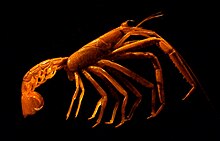Neoglyphea
| Neoglyphea inopinata | |
|---|---|
 |
|
| Scientific classification | |
| Kingdom: | Animalia |
| Phylum: | Arthropoda |
| Subphylum: | Crustacea |
| Class: | Malacostraca |
| Order: | Decapoda |
| Family: | Glypheidae |
| Genus: |
Neoglyphea Forest & de Saint Laurent, 1975 |
| Species: | N. inopinata |
| Binomial name | |
|
Neoglyphea inopinata Forest & de Saint Laurent, 1975 |
|
| External identifiers for Neoglyphea | |
|---|---|
| Encyclopedia of Life | 324959 |
| ITIS | 552906 |
| NCBI | 288654 |
| WoRMS | 382825 |
Neoglyphea inopinata is a species of glypheoid lobster, a group thought long extinct before Neoglyphea was discovered. It is a lobster-like animal, up to around 15 centimetres (5.9 in) in length, although without claws. It is only known from 17 specimens, caught at two sites – one at the entrance to Manila Bay in the Philippines, and one in the Timor Sea, north of Australia. Due to the small number of specimens available, little is known about the species, but it appears to live up to five years, with a short larval phase. A second species, previously included in Neoglyphea, is now placed in a separate genus, Laurentaeglyphea.
Neoglyphea inopinata was named in 1975 by Jacques Forest and Michèle de Saint Laurent of the Muséum national d'histoire naturelle in Paris. It was based on a single damaged specimen that had been caught by the USFC Albatross in the Philippines in 1908, and deposited in the United States National Museum. De Saint Laurent examined the unidentified specimen while working on Thalassinidea at the Smithsonian Institution. The name Neoglyphea means "new Glyphea", while the specific epithet means "unexpected".
A second extant species of glypheoid was originally placed in the genus Neoglyphea as Neoglyphea neocaledonica, but was later split into a separate genus, Laurentaeglyphea.
...
Wikipedia

